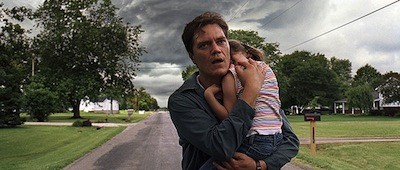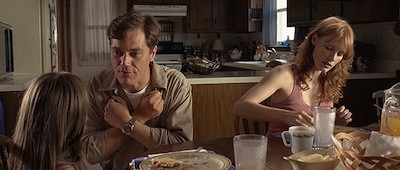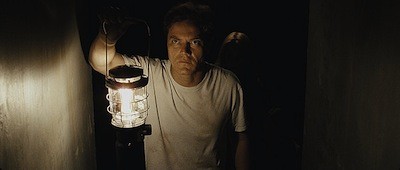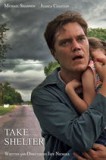| Reviews & Columns |
|
Reviews DVD TV on DVD Blu-ray 4K UHD International DVDs In Theaters Reviews by Studio Video Games Features Collector Series DVDs Easter Egg Database Interviews DVD Talk Radio Feature Articles Columns Anime Talk DVD Savant Horror DVDs The M.O.D. Squad Art House HD Talk Silent DVD
|
DVD Talk Forum |
|
|
| Resources |
|
DVD Price Search Customer Service #'s RCE Info Links |
|
Columns
|
|
|
Take Shelter

Curtis has been having bad dreams. The man sees storms bearing down on his Ohio property, and the mist brings with it mysterious figures intent on doing him harm. When he tries to protect his friends and family, things only get worse. Especially when his family starts to turn on him. He wakes up in a sweat, as anyone would, but unlike most people, the dreams linger for Curtis. An imagined dog bite hurts for the rest of the day. Then he starts to see things in broad daylight, like birds flying in weird patterns. He hears thunderclaps no one else hears. Are his dreams the portent of something real, or is he just losing his mind?
How you answer that question will dictate how you feel about Take Shelter, the debut film from writer/director Jeff Nichols. It stars Boardwalk Empire's Michael Shannon as Curtis, a loving husband and father who earns a good paycheck digging foundations and clearing land. His wife, Samantha (Jessica Chastain, The Tree of Life), sews curtains and pillows to make money for their summer vacation at Myrtle Beach. Curtis' health insurance will cover cochlea implants for their daughter Hannah (Tova Stewart), ensuring that the young girl will hear again. It's a good life. Some folks question why Curtis doesn't go to church, but it's good nonetheless.
All the more tragic, then, that things are falling apart. The intersection of delusion and reality is not a comfortable place, and Curtis' increasing inability to tell the difference between the two is causing him to lose a grip on his day-to-day living. A doctor tells him that only a few days of restless slumber are not a enough to indicate greater problems, but Curtis' mother (Kathy Baker, Picket Fences) was diagnosed as a schizophrenic in her mid-30s. Curtis is 34. Could he be going the same way?

Take Shelter winds tighter the deeper we get into Curtis' story. Nichols keeps the film on an even keel, never ramping up the histrionics even as the dreams grow progressively surreal (one with a flock of birds is particularly unsettling). The events speak for themselves, and Shannon's increasingly fragile state does more than any shouting or demonstrably crazy behavior would. (Though, his one loud outburst is also effective, partially for being the one explosion in the quiet; like an isolated semi truck barreling through a stream of slow-moving Priuses.) Shannon carries the audience in his palm as he takes Curtis about his business. The man becomes obsessed with the tiny storm shelter in his backyard, expanding it and adding all manner of safety gear, no matter the cost to his bank account, his family, or well being. It's like The Mosquito Coast if Harrison Ford had dug underground.
Nichols keeps us on a precarious fence throughout. Sure, Curtis is probably crazy...but what if he isn't? Adam Stone's beautiful photography uses the wide-open spaces of America's heartland against itself. When the majesty is marred by dark clouds and light, the shifting weather is all the more malevolent because of what it obscures. On the same note, Curtis' breakdown is ten times more troubling placed next to the suffering of his wife. Chastain portrays Samantha as a loving woman capable of shouldering any burden and adaptable to the worst of conditions. Her steadiness makes him look all the more erratic. Credit is due to the actress for grounding Samantha without making her overly goody-goody or mawkish. It's a fine performance, equal in importance and power to her co-star's.
If anything, Nichols shows himself adept at inspiring an unstoppable sense of dread in his audience. As political metaphor, Take Shelter is a movie about the crises of our time, about changing landscapes and financial worry and other seemingly unsolvable problems; as a story of personal travails, it opens a hole that anyone would fear, one that it seems impossible to climb out of. However you see it, Take Shelter keeps you watching and keeps you guessing all the while. The only downside is that dread shifts a little in the final act, when it becomes hard to see any satisfying way out of this narrative. Arguably, Nichols offers two possible endings. The movie has an emotional climax and then an epilogue, and it's that epilogue that will divide moviegoers. My friend and I debated the last scene of Take Shelter the whole way home, and I got a text about it from another critic at the screening while we were in the car. The consensus was that, even if we aren't sure what to think about it, the ending worked. The climax could have also worked as an ending, though with a totally different impact. Would one have been better than the other, is there an ending too many here? I can't say. I still can't come up with a better solution for how I would have liked it to have gone.
Perhaps that's the movie's genius, though. It remains inscrutable to its final frame. Nichols never sells himself out by explaining what shouldn't be explained. Take Shelter is designed to be less about plot and more about effect, and love it or hate it, when you leave the cinema, it will have worked on you in some way whether you wanted it to or not.

Jamie S. Rich is a novelist and comic book writer. He is best known for his collaborations with Joelle Jones, including the hardboiled crime comic book You Have Killed Me, the challenging romance 12 Reasons Why I Love Her, and the 2007 prose novel Have You Seen the Horizon Lately?, for which Jones did the cover. All three were published by Oni Press. His most recent projects include the futuristic romance A Boy and a Girl with Natalie Nourigat; Archer Coe and the Thousand Natural Shocks, a loopy crime tale drawn by Dan Christensen; and the horror miniseries Madame Frankenstein, a collaboration with Megan Levens. Follow Rich's blog at Confessions123.com.
|
| Popular Reviews |
| Sponsored Links |
|
|
| Sponsored Links |
|
|
| Release List | Reviews | Shop | Newsletter | Forum | DVD Giveaways | Blu-Ray | Advertise |
|
Copyright 2024 DVDTalk.com All Rights Reserved. Legal Info, Privacy Policy, Terms of Use,
Manage Preferences,
Your Privacy Choices | |||||||











